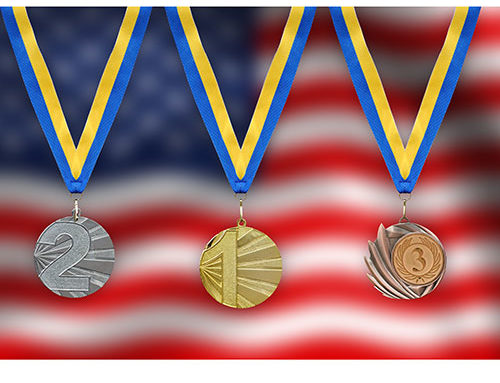On the 4th Day of Christmas, Gym Santa Gave To Me…
4 Days of Trials!
And by “Trials” I’m referring to both world championship trials and Olympic Trials, and the four days can come from two days of the U.S. Championships and two days of a final trials competition, just like we used to do it. Remember the 1992 and 1996 Olympic Trials? Sadly, many of you do not, because that was now nearly twenty years ago, at a time when – believe it or not – selection committees and selection camps didn’t exist. In those days, the performances of the gymnasts and the scores they earned in competition determined their Olympic fates. The competitions were fierce, suspenseful, and dramatic, and although emotions ran high and there certainly was no shortage of heartache and controversy, there was a sense of fairness in watching the destined Olympians emerge to the surface, one by one, with poise and brilliance under pressure. Those competitions captured the true Olympic spirit because the gymnasts themselves wrote their own Olympic stories. The best part of all was that we fans were welcomed into the tale, not only as direct witnesses of the magical stories as they unfolded, but as active contributors to the outcomes with our enthusiastic cheers and chants. Today we fans are not only left out of the Olympic stories we once helped create, we aren’t even invited to watch them unfold anymore. The huge competition arenas where we once all gathered to experience those exhilarating and memorable athletic moments together have been transformed to closed-doors gyms shrouded in secrecy, and to small conference rooms where thrilling performances have been replaced by discussions over coffee. For this Christmas, I wish for a return to a competition-based sport in which Olympic dreams are won and lost rather than given and taken away. Isn’t that what athletics is all about anyway?
On the 5th Day of Christmas, Gym Santa Gave To Me…
5 Meets Per Gymnast Each Year!
Dropping out of competitions has become some sort of fashionable epidemic over the last ten years. Perhaps it is a combination of factors that has led to this worrisome trend. For starters, the dramatic increase in difficulty standards has led to an increased rate of injuries, and the overall increased fitness level a gymnast is required to achieve to be competitive today likely makes many gymnasts more hesitant to salute a judge than in years past. Alongside these greater physical demands, the decreased emphasis on competing all six events and increased focus on specialists has made it much more acceptable to bow out of at least some events. And as we’ve seen frequently, scratching one or two events often progresses into simply scratching the meet altogether. I have to believe, though, that a large contributor is the dramatic change in selection procedures that has occurred over the past 15 years and the tremendous importance of reputation under today’s subjective system. Gymnasts and coaches tend to take a more defensive approach to competition out of concern for how potential mistakes or sub-par performances might negatively influence their chances to be selected for future competitions. It isn’t uncommon nowadays for some of our top gymnasts – male and female – to compete in only one or two competitions in an entire year, despite training 6 days a week for 4-8 hours per day! For this Christmas, I wish that gymnasts and coaches will take a more offensive approach to competition and compete in at least five meets per year, even if not totally 100%. Unfortunately, “100%” often never comes, and what was initially perceived as “strategy” turns out to be nothing more than missed opportunities in disguise.
On the 6th Day of Christmas, Gym Santa Gave To Me…
6 Gymnasts In Team Finals!
It’s now been exactly ten years since the three-up-three-count team finals format was first introduced, and I find myself longing more and more for the real team formats of days past. The presumed suspense and drama of the three-up-three-count format has always been theoretically intriguing but has never really played out that way on the actual competition floor. Rotations go by too quickly for any sense of suspense, tension, or “team momentum” to actually build, and the meet is never conducted in such a way that spectators actually know who’s winning or how close the competition truly is at any given moment. I miss the more developed team stories of the old team formats, which actually had a beginning, a middle, a climax, and an end, rather than being started and abruptly finished in the same sentence. Let’s be honest…would the U.S. men’s team gold in 1984 or the Magnificent Seven’s gold in 1996 have been nearly as dramatic or memorable if only three gymnasts competed on each event? Remember, it wasn’t the end results of those competitions that made them so enchanting…it was the emotional team journeys it took to get there. It was the fact that all team members were depended upon to hit routines under pressure, one after another, and the fact that the audience felt the ups and downs of the ride as they watched the winning team write their inspiring story throughout the night. Today’s team finals seem more like individual circus acts – with most competitors sitting on the bench – rather than a true team competition in which all gymnasts must step up to the plate in a successive fashion and go to bat. This Christmas, I ask for a return to a team finals format that captures the true spirit of team competition, in which all team members actually wear competition uniforms together rather than warm-up jackets, and in which teammates depend on each other to hit routines rather than move mats around.
Stay tuned for Days 7-9!



Leave A Comment